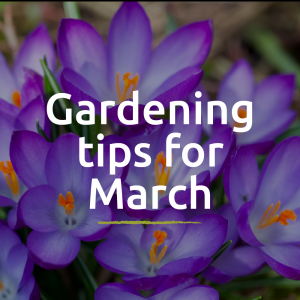Gardening Jobs for March
March madness
The first signs of spring are here! Narcissus, snowdrops and crocuses are bringing much needed colour to autumnal hues. The days are getting longer and the weather warmer, which means there is more time to spend in the garden.
This March is full of madness. On catch-up from the snow we had in January and February, along with the floods and wind, means there are possibly more jobs to do than normal.
Even though it is getting warmer, keep an eye on the weather forecast as March is prone to good ground frosts, which may catch you unawares and potentially damage less-hardy plants.
March is the time to roll up those sleeves and dig deep as we start final preparations for the forthcoming season.
Beautiful blooms:
- Hard prune roses and lingering dead leaves. They will also benefit from a spring feed such as Organic Rose Feed. This slow-release fertiliser will not only condition the soil, but also slowly release nutrients for bountiful blooms throughout the growing season.
- Plant clematis and divide perennials plants. Once divided, re-plant with a sprinkling of blood, fish and bone which will help with strong root growth.
- Plant lilies and pick off any seed heads from winter flowers such as pansies and hydrangeas. Continue to deadhead spring flowers.
- If you have rhododendrons, azaleas etc, feed with a specialist fertiliser such as Azalea, Rhododendron & Shrub Fertiliser. It can also double up as feed for blueberry and raspberry plants.
- Start to think about planting summer flowering bulbs and finish cutting back perennials and ornamental grasses.
- If frost is forecast, then protect plants which are not frost-hardy.
Fruit & Veg:
- As the soil starts to warm, add mulches around fruit bushes and established trees for extra, organic nutrients.
- Now is the time to sow! Sow tomatoes, chillies, peppers and cucumbers indoors. Add a handful of Vitax Q4 to the soil for an added boost.
- Plant onion and shallot sets.
- Sow cabbage seed indoors now for an autumn crop. In the meantime dig over the soil bed and manure with 6X Natural Plant Feed. When the cabbage plants have three or more leaves work a heavy dressing of Garden Lime into the soil surface and transplant the seedlings every 45cm in rows 60cm apart.
- Strawberries are great to grow in the garden, but are a slug favourite. Plant them in hanging baskets, they will look fabulous, but also keep slugs at bay.
- As fruit trees come into blossom, protect with fleece.
- Now is the time to plant hardy vegetable such as carrots, peas, spinach and beetroot.
- Celeriac, early potatoes and Kale can be planted early-March with leeks, turnips and cauliflower mid-end March.
Pests:
- As the season starts to wake, so do bugs and pests. You will see an increase in aphids this month. Many people pick them off, but using Organic Plant Guard will protect plants.
- Slugs. These tend to be a year-round problem, but as you start to plant out new shoots, you not only have to protect against hungry birds, but also slugs. Protect young shoots with Slug Gone, a natural deterrent, it will prevent slimy slugs nibbling those crops and the pellets mulch down too.
- As you start to move some of the seedlings outside, thoroughly clean your trays and work stations in the greenhouse with a greenhouse disinfectant to prevent the spread of any disease.
- Weeds will now start to grow, so keep on top of these and weed as you go.
Lawn:
- It’s time to sow and mow! If there are areas of a lawn that are in a need of a cut, on a dry day, set a high mower blade and take the top off.
- If the soil is warm and moist and the lawn is showing signs of wear and tear, March is the time to sow new lawn seed.
- If the lawn has plenty of weeds, think about applying a feed and weed, but read the instructions carefully.
- Now is a great time to get on top of any moss problems in the lawn before scarification in Spring. One way to tackle moss is by using Lawn Sand. Apply using a spreader, or by hand on small areas. It will quickly kill moss and turn the moss black so you can see any areas that have been missed. The dead moss can then be removed by raking or scarifying.
If you still have time after all the growing, weeding and feeding, then the water butts will need a good clean as well as all the tools.
Happy, busy gardening!
Your login details have been used by another user or machine. Login details can only be used once at any one time so you have therefore automatically been logged out. Please contact your sites administrator if you believe this other user or machine has unauthorised access.














